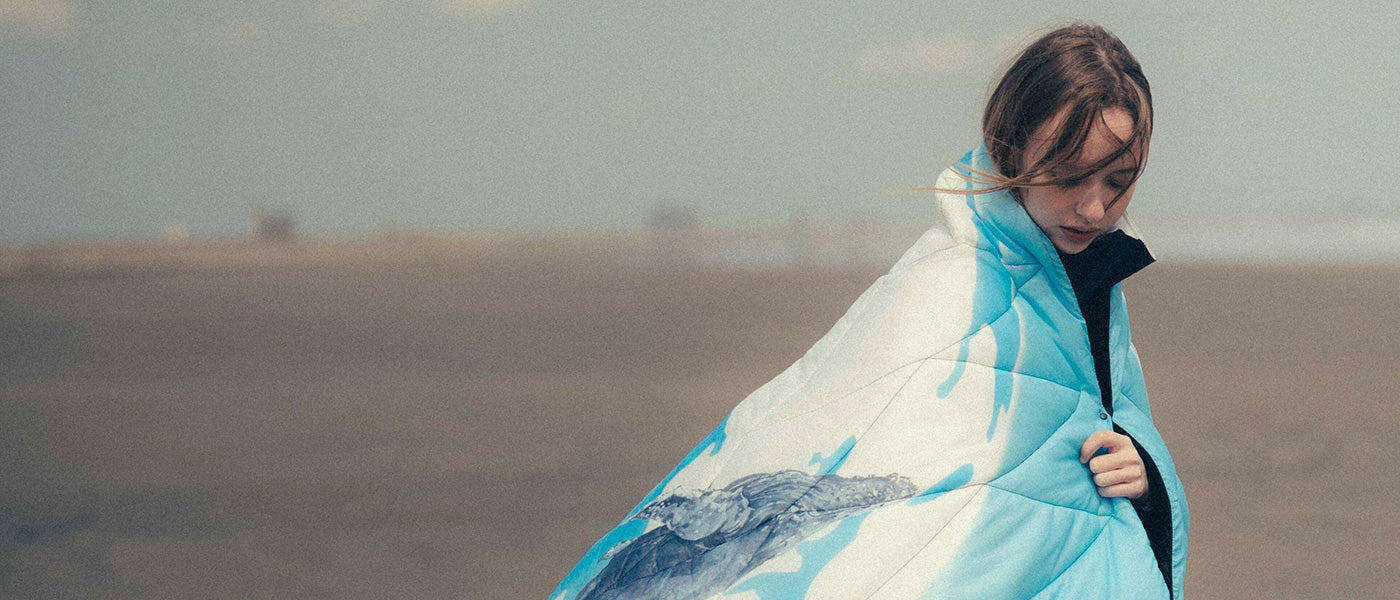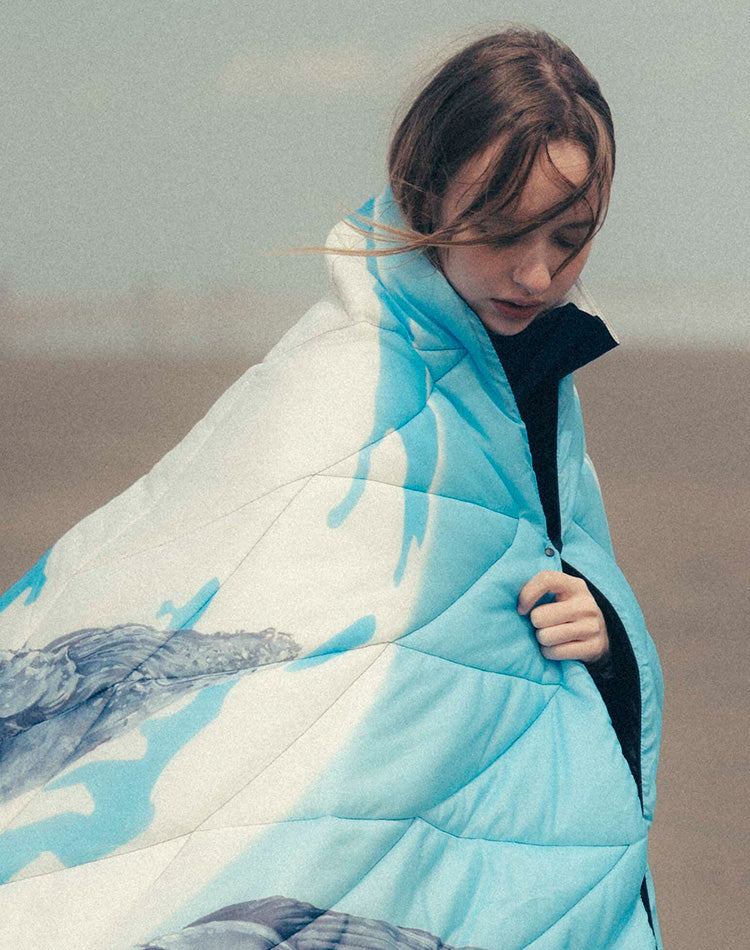FEATURE 24
Getting the job done. 2020 Autumn/Winter Collection
Site of visual creations
Nishiyama (as T):These visuals were created, while information on the complications of COVID-19 was beginning to circulate.
Hasegawa (as H):At first, we had ideas of the shooting on location, not just still, but possibly even video footage, but due to the situation with COVID-19, we weren't sure if it was okay to shoot outside. After discussing further, it led me to the idea of creating collages. We could then add the background locations within the picture. I imagined adding mountains to create a fake look of being in the mountains but not physically being there to shoot.
T:
Moving forward with the collage technique, we were able to control the world the image portrayed. You are very familiar and have been working with collages for a while, right?
H:
Yeah, that's right. I started to clip and collage about 20 years ago, but the way I do things now is a mix of how Maeda of AD came up with when I was working for POPEYE, adding my method into it as well. I don't know if anyone fully understands what it is. (Laughs)
Winter fashion photography can be rough to shoot when it's conducted in the middle of summer, so a collage is an excellent solution to that problem. It also worked out for us when the state of emergency was declared and restrained to only working from home.
The situation left us unable to shoot models or products, so I tried the clothes on myself and took selfies to retouch those images… It was definitely hard to do the shoot and the retouching on my own. There were minor mistakes, but I contribute it to its uniqueness. It was also fun to do everything from the beginning to the end by myself.
T:
I am sure you see the final visual… While shooting a model wearing one coordinated set, I believe you see the overall structure, using the shot as material for a collage. I try to concentrate on the role of directing the story when we process these styles. The techniques of choosing images from a large amount of material that's shot on site is an art direction that goes beyond the boundaries of a stylist.
H:
It’s actually really fumbling, but…

T: I like your collages, especially the one layered with the down jacket, that has a particular style. I can tell whose work it is immediately. I don't think it could have been done if you worked as a stylist and a designer. After all, I think your work will change the future. H: In my case, there is a point I want to show on the clothes and try to present it from that perspective. There are many times when art directors and photographers don't understand me when we are in discussions. My job is to create fashion visuals, and at the end of the day, the clothes need to sell. Art directors don't understand the idea that fashion directors create the visuals, and at the same time, consider that their work territory is being violated. It's the same for photographers, they tend to choose the people and photos that look cool from an artist's point of view, but I'm also considering the shapes and silhouettes of the clothes, so it is hard to communicate. It can be challenging to work with if they can't understand that view. T: I think the industry is gradually changing its work area. I think that the way we are involved has changed, the position of showcasing products. H: The work can be tough if you cannot fully enjoy it from the bottom of your heart. Recently, the number of advertising projects has increased, but I sometimes wonder if it suits me… I prefer not to have a client with a substantial party involvement or advertisement agencies. In comparison, at DESCENDANT, I can be the person in charge and have discussions and suggestions to create whatever I want to create. It is enjoyable. I'd say it similar to the feeling of making a magazine.

T:
Typically, collaborations are like that. The willingness to work together has to be shared. I think there is a difficulty in directing each other's world views neutrally. However, as I mentioned earlier, I wonder if showcasing the products was the mutual goal and shared between them. If so, there would be no problems. Nowadays, I believe it is essential for us and the brand, which we created from nothing, to be expressed by someone and change its shape.
H:
It's interesting that the item page of the catalog has a caption, the DESCENDANT catalog is really like a magazine, and you are the editor in chief. In my case, when being offered work, I am more than happy when my clients are excited with the outcome of my work, and if my work is a contributing factor to the brand's sales, well, that leaves me speechless. As for the visual, if you just use the shot photographs to create a collage, the resulting image will look flat. By using the created collage as the base and then adding the digital photo images atop, gives depth to the collages’ final results. I have always been particular about areas that typical go unnoticed. I don't like it being thought of as just an art piece. It is fashion, so it doesn't make sense unless viewers of the website and the catalog get a feeling of wanting the products. I think changing the colors of the background of the collages brought it closer to the image of DESCENDANT.
Regarding the models, Yoppi and his son were special, I felt the professional models were not attractive enough. On the other hand, I think skaters are more suitable as models. I like how the muscles are formed from their movements and the habits that protrude from their lifestyle appears on their bodies, those things permeate when I dress them up.
T:
Certainly, there are many moving pictures when you shoot.
H:
Yes, I like taking shots of people in motion.

T: Were you influenced by Michael Jordan's “The Last Dance” that you were watching during the shoot? H Yes, I was also looking at the old pictures of “Sports Illustrated magazine” and “Number magazine,” which affected me in various ways. For instance, looking at Michael Jordan's image, my eyes immediately focused on his shorts, turned inside out at the leg opening, and his knee support brace. There is a photo book that was created by John C Jay of former Wieden + Kennedy in the '90s, it was a photograph of players playing basketball on a white background, I was surprised that the viewpoints were very similar to mine, such as the rise of muscles and the shape of the supporters. I also like the lively look of people playing sports. That's why I might ask models to move around. T: Nice to understand why you move models around. H: Basically, I try not to give much instructions to the models. In the past, when I tried to convey the settings, a poorly acted play would begin. Even though I knew what I wanted to portray, I couldn't express and explain it in words, and so I had to continue watching this horrible act play out. T: I think it is vital to share senses when we collaborate. However, for these visuals, I was in a bit of trouble cause you had requested for graphics and texts. (Laughs) H: It may be common to the generations who started the brands in Harajuku, but it seems that they are good at expressing graphics, probably because they were introduced to Mac products and created graphics themselves at an early stage. Especially you, you are an apparel designer, I don't think there is anyone as good at graphic skills and its sense of balance. It was an opportunity for me, so I wanted to use your graphics. Because I write the manuscript myself, I came to think about the importance of communicating in words. We are usually used to creating visuals, so I think we have high sensitivity to them. Still, many people are easier to understand by communicating with words, and that's why I am particular with words as well. Your words have such a strong power. T: I don't think you can write the texts attached to the products without knowing the history of the brand and the creators, and it's a collection of various materials, including the product shots. This catalog or booklet is created by people who like clothes, gathering, and coming together. H: Speaking not only for this catalog but the model selection in general. I try to use guys with a cool look. Of course, it is important to have individuality and create impression, but they need to be handsome more overall. It just makes it easier to view. T: When I create the clothes, I often think about who will wear it, but at DESCENDANT, the concept is first, to create what I want to wear. I don't want to be selfish in the clothes design, but also do not want to create something that everyone will accept. Pursuing the uniqueness of DESCENDANT increases the hurdles of wearing it, and if the person who bought the product seems unable to wear it, then it is a fail. I especially feel this way when inputting new suggestions, resurrecting old ones, and presenting unique items. In fact, at the design site, we are sometimes exposed to our staff’s watchful eyes and regain confidence and vice versa. As for the models, three different generations were appointed, Yoppi, for the middle-aged, SOUSHI, for the young and Yoppi’s son Yukumo, for the kids. I think it's a well balanced casting. H: In the case of Yoppi, he himself has history, and so wanted to connect the clothing to that history. T: I don't think there are many people with that kind of character. H: That's why, even when I say I want to use cool models, a professional model just doesn't cut it. Someone like Yoppi is very valuable. T: If we started to pick from a model’s personal character, it would become endless. (Laughs) H: Yeah, but the model's personality is also important. If they are more open and accepting, it is easy for us to work together, and if they are troublesome, I wouldn't want to work with them again. (Laughs) T: Anyway, with the cooperation between various people who love clothes, the latest catalog of DESCENDANT was completed by the gathering of many materials. From this season, you will see many visuals online, and I think it has become a very fulfilling content.



